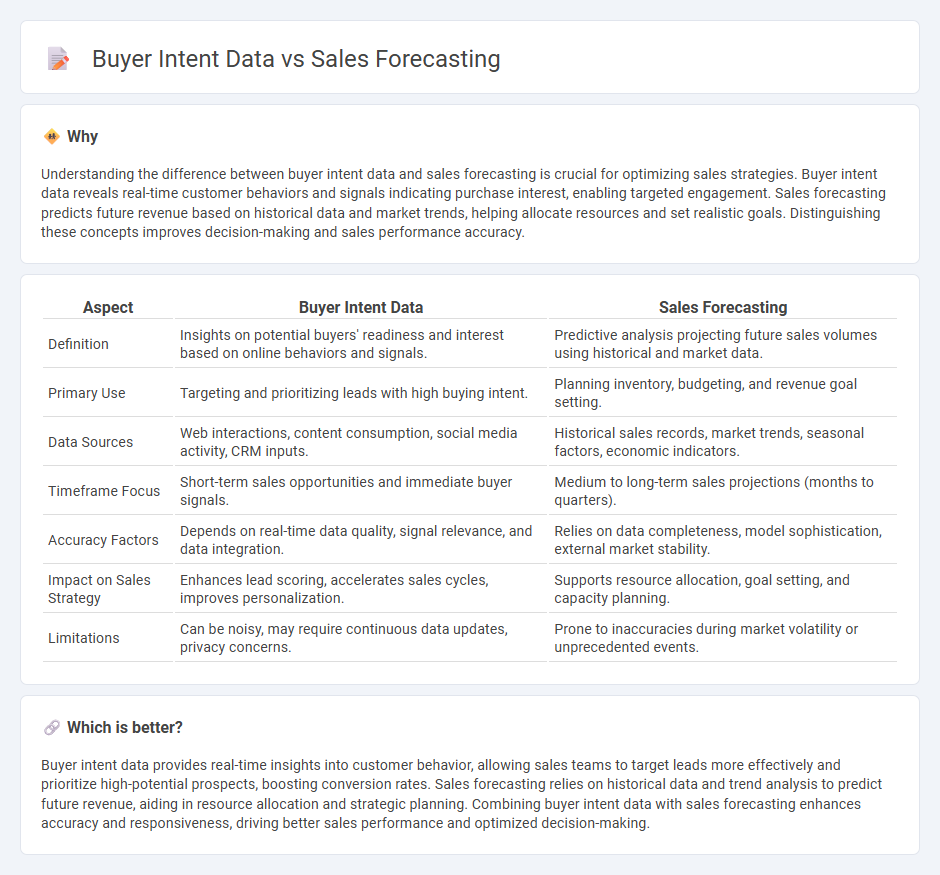
Buyer intent data provides real-time insights into potential customers' behaviors and preferences, allowing sales teams to target prospects with precision. Sales forecasting relies on historical data and predictive analytics to estimate future sales performance and revenue trends. Explore how combining buyer intent data with sales forecasting can revolutionize your sales strategy.
Why it is important
Understanding the difference between buyer intent data and sales forecasting is crucial for optimizing sales strategies. Buyer intent data reveals real-time customer behaviors and signals indicating purchase interest, enabling targeted engagement. Sales forecasting predicts future revenue based on historical data and market trends, helping allocate resources and set realistic goals. Distinguishing these concepts improves decision-making and sales performance accuracy.
Comparison Table
| Aspect | Buyer Intent Data | Sales Forecasting |
|---|---|---|
| Definition | Insights on potential buyers' readiness and interest based on online behaviors and signals. | Predictive analysis projecting future sales volumes using historical and market data. |
| Primary Use | Targeting and prioritizing leads with high buying intent. | Planning inventory, budgeting, and revenue goal setting. |
| Data Sources | Web interactions, content consumption, social media activity, CRM inputs. | Historical sales records, market trends, seasonal factors, economic indicators. |
| Timeframe Focus | Short-term sales opportunities and immediate buyer signals. | Medium to long-term sales projections (months to quarters). |
| Accuracy Factors | Depends on real-time data quality, signal relevance, and data integration. | Relies on data completeness, model sophistication, external market stability. |
| Impact on Sales Strategy | Enhances lead scoring, accelerates sales cycles, improves personalization. | Supports resource allocation, goal setting, and capacity planning. |
| Limitations | Can be noisy, may require continuous data updates, privacy concerns. | Prone to inaccuracies during market volatility or unprecedented events. |
Which is better?
Buyer intent data provides real-time insights into customer behavior, allowing sales teams to target leads more effectively and prioritize high-potential prospects, boosting conversion rates. Sales forecasting relies on historical data and trend analysis to predict future revenue, aiding in resource allocation and strategic planning. Combining buyer intent data with sales forecasting enhances accuracy and responsiveness, driving better sales performance and optimized decision-making.
Connection
Buyer intent data provides critical insights into customer behavior and purchasing signals, enabling sales teams to prioritize leads with the highest potential. Integrating this data into sales forecasting models enhances accuracy by aligning predictions with real-time market demand and buyer readiness. This connection allows businesses to optimize resource allocation, improve revenue projections, and tailor sales strategies effectively.
Key Terms
**Sales Forecasting:**
Sales forecasting utilizes historical sales data, market trends, and statistical models to predict future revenue and inform business planning. It enables companies to allocate resources efficiently, set realistic targets, and anticipate demand fluctuations. Explore more about how accurate sales forecasting can drive strategic growth and improve decision-making.
Pipeline Analysis
Sales forecasting relies on historical sales data and market trends to predict future revenue, offering a quantitative foundation for pipeline analysis. Buyer intent data captures real-time signals from buyers' digital behavior, providing granular insights into customer interest and engagement within the sales funnel. Explore how combining these strategies enhances pipeline accuracy and drives more effective sales decisions.
Historical Data
Sales forecasting relies heavily on historical sales data, analyzing past trends and seasonal patterns to predict future revenue with high accuracy. Buyer intent data captures current signals from prospects' online behavior to gauge their readiness to purchase, offering real-time insights often absent in historical datasets. Explore how integrating historical sales forecasting with dynamic buyer intent data can enhance predictive accuracy and decision-making.
Source and External Links
Sales Forecasting | Salesforce - Sales forecasting involves estimating expected sales revenue over a defined period by analyzing historical sales data, current pipelines, and market conditions using various methods like historical and pipeline forecasting to project future sales.
What is Sales Forecasting? - DealHub - Sales forecasting estimates future sales to optimize revenue through combined methods such as market analysis, historical data review, and sales tools, while emphasizing flexible adjustments as new data arises.
Sales Forecasting Methods: A Beginner's Guide - Anaplan - Sales forecasting predicts future revenue by estimating product or service sales over various time frames, playing a crucial role for business planning, budgeting, and operations across departments with multiple forecasting types aligned to go-to-market strategies.
 dowidth.com
dowidth.com